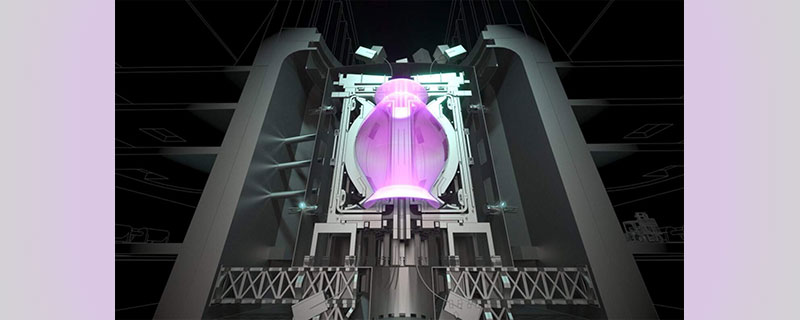The Fiendish Challenges of Fusion Power
“Fiendish”, “technically tough”, “difficult”, “complicated”. Those were just a few of the choice words used at an event last week in Oxfordshire, UK, to describe ambitious plans to build a prototype fusion power plant. Held at the UK Atomic Energy Authority (UKAEA) Culham campus, the half-day meeting on 5 September saw engineers and physicists discuss the challenges that lie ahead as well the opportunities that this fusion “moonshot” represents.
The prototype fusion plant in question is known as the Spherical Tokamak for Energy Production (STEP), which was first announced by the UK government in 2019 when it unveiled a £220m package of funding for the project. STEP will be based on “spherical” tokamak technology currently being pioneered at the UK’s Culham Centre for Fusion Energy (CCFE). In 2022 a site for STEP was chosen at the former coal-fired power station at West Burton in Nottinghamshire. Operations are expected to begin in the 2040s with STEP aiming to prove the commercial viability of fusion by demonstrating net energy, fuel self-sufficiency and a viable route to plant maintenance.
A spherical tokamak is more compact than a traditional tokamak, such as the ITER experimental fusion reactor currently being built in Cadarache, France, which has been hit with cost hikes and delays in recent years. The compact nature of the spherical tokamak, which was first pioneered in the UK in the 1980s, is expected to minimize costs, maximise energy output and possibly make it easier to maintain when scaled up to a fully-fledged fusion power plant.
The current leading spherical tokamaks worldwide are the Mega Amp Spherical Tokamak (MAST-U) at the CCFE and the National Spherical Torus Experiment at the Princeton Plasma Physics Laboratory (PPPL) in the US, which is nearing the completion of an upgrade. Despite much progress, however, those tokamaks are yet to demonstrate fusion conditions through the use of the hydrogen isotope tritium in the fuel, which is necessary to achieve a “burning” plasma. This goal has, though, already been achieved in traditional tokamaks such as the Joint European Torus, which turned off in 2023.
“STEP is a big extrapolation from today’s machines,” admitted STEP chief engineer Chris Waldon at the event. “It is complex and complicated but we are now beginning to converge on a single design [for STEP]”.
A fusion ‘moonshot’
The meeting at Culham was held to mark the publication of 15 papers on the technical progress made on STEP over the past four years. They cover STEP’s plasma, its maintenance, magnets, tritium-breeding programme as well as pathways for fuel self-sufficiency (Philosophical Transactions A 382 20230416). Officials were keen to stress, however, that the papers were a snapshot of progress to date and that since then some aspects of the design have progressed.
One issue that crept up during the talks was the challenge of extrapolating every element of tokamak technology to STEP – a feat described by one panellist as being “so far off our graphs”. While theory and modelling have come a long way in the last decade, even the best models will not be a substitute for the real thing. “Until we do STEP we won’t know everything,” says physicist Steve Cowley, director of the PPPL. Those challenges involve managing potential instabilities and disruptions in the plasma – which at worst could obliterate the wall of a reactor – as well as operating high-temperature superconducting magnets to confine the plasma that have yet to be tested under the intensity of fusion conditions.
We need to produce a project that will deliver energy someone will buy
Ian Chapman
Another significant challenge is self-breeding tritium via neutron capture in lithium, which would be done in a roughly one-metre thick “blanket” surrounding the reactor. This is far from straightforward and the STEP team are still researching what technology might prevail – whether to use a solid pebble-bed or liquid lithium. While liquid lithium is good at producing tritium, for example, extracting the isotope to put back into the reactor is complex.
Howard Wilson, fusion pilot plant R&D lead at the Oak Ridge National Laboratory in the US, was keen to stress that STEP will not be a commercial power plant. Instead, its job rather is to demonstrate “a pathway towards commercialisation”. That is likely to come in several stages, the first being to generate 1 GW of power, which would result in 100 MW to the “grid” (the other 900 MW needed to power the systems). The second stage will be to test if that power production is sustainable via the self-breeding of tritium back into the reactor, what is known as a “closed fuel cycle”.
Ian Chapman, chief executive of the UKAEA, outlined what he called the “fiendish” challenges that lie ahead for fusion, even if STEP demonstrates that it is possible to deliver energy to the grid in a sustainable way. “We need to produce a project that will deliver energy someone will buy,” he said. That will be achieved in part via STEP’s third objective, which is to get a better understanding of the maintenance requirements of a fusion power plant and the impact that would have on reactor downtime. “We fail if there is not cost-effective solution,” added STEP engineering director Debbie Kempton.
STEP officials are now selecting industry partners — in engineering and construction — to work alongside the UKAEA to work on the design. Indeed, STEP is as much about physically building a plant as it is creating a whole fusion industry. A breathless two-minute pre-event promotional film — that loftily compared the development of fusion to the advent of the steam train and vaccines — was certainly given a much needed reality check.
Source: Physics World







Leave a Reply
Want to join the discussion?Feel free to contribute!